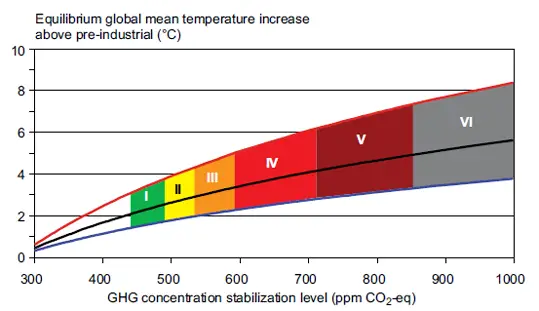Long Term Mitigation – after 2030 (from IPCC AR4, WGIII, Summary for Policy Makers)
In order to stabilize the concentration of GHGs in the atmosphere, emissions would need to peak and decline thereafter. The lower the stabilization level, the more quickly this peak and decline would need to occur. Mitigation efforts over the next two to three decades will have a large impact on opportunities to achieve lower stabilization levels.
1. The range of stabilization levels assessed can be achieved by deployment of a portfolio of technologies that are currently available and those that are expected to be commercialised in coming decades. This assumes that appropriate and effective incentives are in place for development, acquisition, deployment and diffusion of technologies and for addressing related barriers.
The contribution of different technologies to emission reductions required for stabilization will vary over time, region and stabilization level. Energy efficiency plays a key role across many scenarios for most regions and timescales for long term mitigation. For lower stabilization levels, scenarios put more emphasis on the use of low-carbon energy sources, such as renewable energy and nuclear power, and the use of CO2 capture and storage (CCS).
In these scenarios improvements of carbon intensity of energy supply and the whole economy need to be much faster than in the past. Including non-CO2 and CO2 land-use and forestry mitigation options provides greater flexibility and cost-effectiveness for achieving stabilization. Modern bioenergy could contribute substantially to the share of renewable energy in the long term mitigation portfolio.

Stabilization scenario categories (coloured bands) and their relationship to equilibrium global mean temperature change above pre-industrial, using (i) “best estimate” climate sensitivity of 3°C (black line in middle of shaded area), (ii) upper bound of likely range of climate sensitivity of 4.5°C (red line at top of shaded area) (iii) lower bound of likely range of climate sensitivity of 2°C (blue line at bottom of shaded area). Coloured shading shows the concentration bands for stabilization of greenhouse gases in the atmosphere corresponding to the stabilization scenario categories I to VI.
Investments in and world-wide deployment of low GHG emission technologies as well as technology improvements through public and private Research, Development & Demonstration (RD&D) would be required for achieving stabilization targets as well as cost reduction. The lower the stabilization levels, especially those of 550 ppm CO2-eq or lower, the greater the need for more efficient RD&D efforts and investment in new technologies during the next few decades. This requires that barriers to development, acquisition, deployment and diffusion of technologies are effectively addressed.
Appropriate incentives could address these barriers and help realize long term mitigation across a wide portfolio of technologies.
2. In 2050 global average macro-economic costs for multi-gas mitigation towards stabilization between 710 and 445 ppm CO2-eq, are between a 1% gain to a 5.5% decrease of global GDP. For specific countries and sectors, costs vary considerably from the global average.
3. Decision-making about the appropriate level of long term mitigation over time involves an iterative risk management process that includes mitigation and adaptation, taking into account actual and avoided climate change damages, co-benefits, sustainability, equity, and attitudes to risk. Choices about the scale and timing of GHG mitigation involve balancing the economic costs of more rapid emission reductions now against the corresponding medium-term and long-term climate risks of delay.
Limited and early analytical results from integrated analyses of the costs and benefits of mitigation indicate that these are broadly comparable in magnitude, but do not as yet permit an unambiguous determination of an emissions pathway or stabilization level where benefits exceed costs.
Integrated assessment of the economic costs and benefits of different mitigation pathways shows that the economically optimal timing and level of mitigation depends upon the uncertain shape and character of the assumed climate change damage cost curve. To illustrate this dependency:
o if the climate change damage cost curve grows slowly and regularly, and there is good foresight (which increases the potential for timely adaptation), later and less stringent mitigation is economically justified;
o alternatively if the damage cost curve increases steeply, or contains non-linearities (e.g. vulnerability thresholds or even small probabilities of catastrophic events), earlier and more stringent mitigation is economically justified.
• Climate sensitivity is a key uncertainty for mitigation scenarios that aim to meet a specific temperature level. Studies show that if climate sensitivity is high then the timing and level of mitigation is earlier and more stringent than when it is low.
• Delayed emission reductions lead to investments that lock in more emission-intensive infrastructure and development pathways. This significantly constrains the opportunities to achieve lower stabilization levels and increases the risk of more severe climate change impacts.
